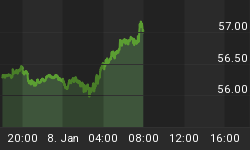Background
The field of technical analysis is based upon chart patterns which have an historical affinity to work a certain way upon completion. A simple example would be a rising wedge formation which develops support and resistance determined by lines drawn on the peaks and dips, ultimately breaks support and then falls to target. Within the formation, one can examine other characteristics such as the directional movement of various oscillators and indicators, volume and money flow, which when taken together may further assist in determining the affinity or degree of probability that the market will move in some predictable way, as in the example of our rising wedge, down.
Like any iffy proposition, technical analysis has always had its critics who believe trying to discern such formations is a waste of time and although attempting to read the tea leaves of stock charts might work on occasion, one would be much better off examining the fundamental properties of the company itself for a basis to buy and sell. They're usually right.
But every critic has a critic and thus the argument of which method is better has been bantered back and forth endlessly since both are widely used. I am of the opinion that technical analysis is often like a fruit bearing tree, in that a formation that takes weeks or months to develop can break rather quickly and thus the sooner one is able to determine, a) that it exists and, b) it is either bullish or bearish, is paramount in order to take advantage of it. Furthermore, if one can spot a pattern which is unconventional, and can play it successfully one can reap profits in a market where others flounder and flail.
I have found a gem of a formation which over the months has yielded me a handsome double-digit profit by trading either long or short at tactical inflection points and I have written this essay to share it with you. I have chosen now as the ideal time because the formation has reached a critical juncture.
The Setup: Today's NASDAQ Has Been Tracing ANN's Post-Rising Wedge Pattern
In 1999, the stock chart of Anntaylor Stores (ANN) developed a rising wedge which broke to the downside, and then made a pattern which looked very similar to an inverse head and shoulders formation, however this instead served as a distribution pattern preceeding a devastating decline. Amazingly, today's Nasdaq's post-rising wedge chart pattern has played out in relation to ANN's 1999 pattern like a Greek drama. Their similar chart action leads me to suspect that, should the similarity continue, there will be an intense decline on the Nasdaq in the coming period.
Lets begin with an examination of the ANN stock chart from 1998-99 when the rising wedge formation appeared. It took nine months to develop and then broke to the downside as anticipated, however instead of declining to target, it began to bobble in what may have appeared at the time to be consolidation or perhaps even in early November an inverse head and shoulders...

...but on closer inspection one can see it took on a distinct appearance. In the post-rising wedge stock action, three unique features became apparent which I have dubbed the "Ws of Doom", and you can see why. The first was directly after the rising wedge had topped and had begun its decline, the second was a more severe drop and recovery to resistance, and lastly was a formation that pierced resistance for a moment before it began its decline in earnest.

After the third "W of Doom" formed and was repulsed shortly after piercing resistance, the stock suffered a severe decline.

Note the similarities on today's Nasdaq and you can see how ANN's past provided the key to the Nasdaq's trajectory at nearly every significant turn: The "Ws of Doom" have formed not just in size but also in proportion to those on ANN from 1999, right down to the negative divergences on both the MACD and the money flow indicators. Though the correlation is not perfect, it does have a striking resemblence which I have thus far been able to successfully exploit.

Conclusion
In the immortal words of Mark Twain, "History doesn't repeat itself, but it does rhyme." Although the recent Nasdaq emulation of ANN's post-rising wedge fallout has been quite correlative, there are no guarantees whatsoever that the Nasdaq will continue off the cliff as did ANN, but should the correlation continue, the market may surprise and confound today's legions of pound-the-table bullish advisors and investors with a sharp decline.
As I said in my previous essay, do not dismiss the possibility of the market reversing and going up, as I leave 24% to that potential scenario. The last 1% is for the possibility of you vanishing in the rapture in which case you won't be around to give a hoot. After all, everyone knows you're a saint. ;-)
Since I am not a professional investment advisor, and am merely a garden variety retail speculator and I'm absolutely not qualified to give investment advice of any kind, my non-advice would be that should the market enter a bear phase, take defensive market positions and to limit losses to an acceptable level, however you define that.
Best regards, and I hope you are having a pleasant day.
















